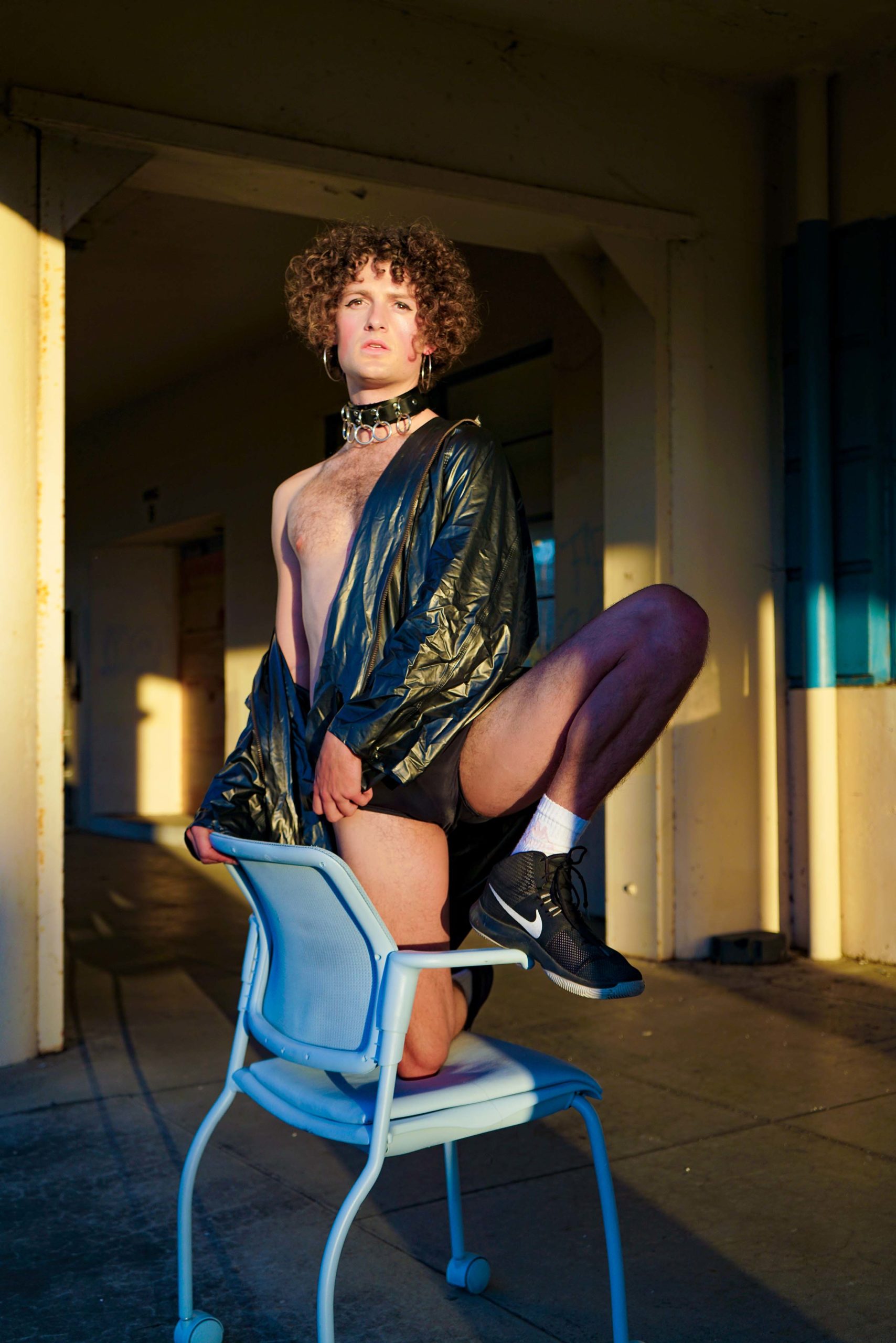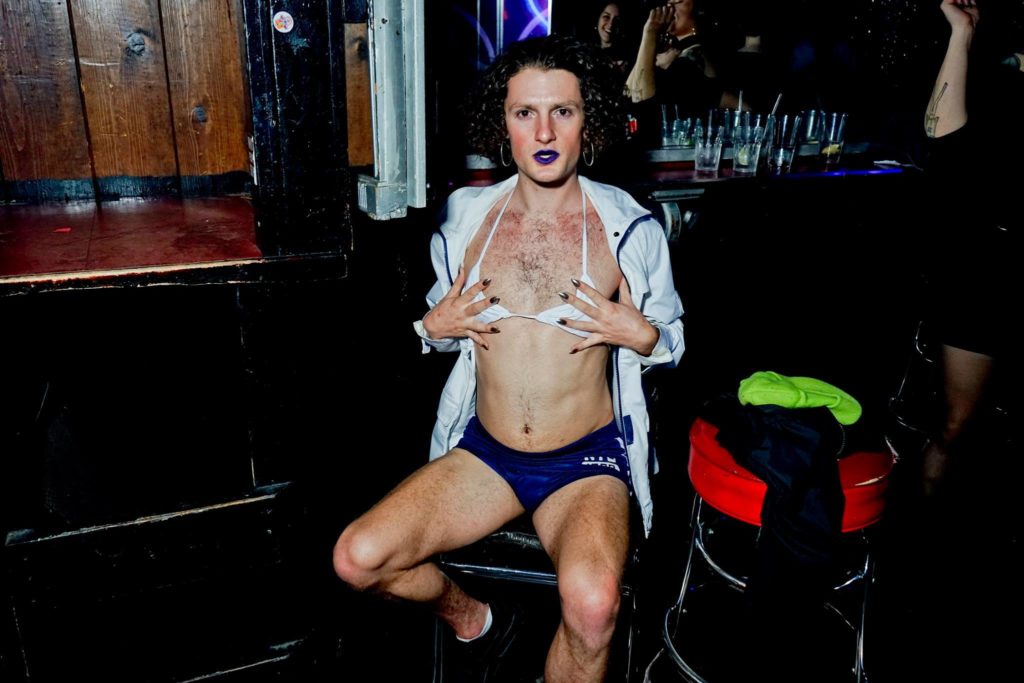
Photo by Guerrilla Davis
[ID: Octavia poses kneeling on a powder blue chair with one foot raised. They are a white person with curly brown hair, wearing a leather collar, silver earrings, shiny black jacket, speedo and sneakers. They are captured in golden hour sunlight in the outdoor hallway of an abandoned building.]
There is a sense of belonging felt deep in my bones that only the dance of a nightclub can bring. As the bass thunders its hypnotic hymn and sweat drips down my gyrating chest, boundaries between myself and the bodies around me begin to disappear. We vibrate as cells in the same large organism; sacks of fluid swimming in a sea of plasma. The pleasure we feel fulfills our deepest human instincts – it digs into a primal reverence towards a higher power, a loss of self in the pursuit of something greater. We leave our social inhibitions behind and for a moment we pulse with collective purpose.
Nightlife has always ignited me with its luscious, alchemical energy. But seven years ago, I began to experience chronic pain and mobility loss in my ankles and feet that made it harder and harder to access these spaces where I thrived. If I wanted to go to a party, I had to scope out seating that was hard to find, or bring a mobility device of my own that wound up crammed into the corner of a crowded dance floor. Once I did find a place to sit, it was often set far away from where my non-disabled friends wanted to dance, which could feel isolating and awkward. Some venues required mile-long walks through uneven terrain to access, or multiple flights of stairs that weren’t advertised in event descriptions. I often found myself needing to leave parties early because I was in too much discomfort, or I simply stayed home and avoided them all together.
I knew I wasn’t the only one who had these experiences, and I started connecting with others who felt similarly. For some, strobe lights and dry ice fog could cause seizures or sensory processing overload. For others, there wasn’t a space at parties to unwind and de-stress when faced with too much stimulation and loud noise. And as the Covid pandemic took hold, access barriers became more and more prevalent for friends who couldn’t risk attending tightly packed, unmasked in-person events.
Through all of this, I began to see the gaps in the structure of a world that prides itself on welcoming difference, but fails to make space for so many in its universe. Truthfully, I might not have considered these issues myself if I hadn’t begun to have my own experience with physical impairment – which showed me just how important it is for a cultural shift in nightlife to take place. How, I wondered, can queer clubs be more welcoming to the disability community? How can disability culture take the lead in re-imagining these spaces?
As I began to ask these questions, I learned about disabled artists across the world who were conjuring their own accessible nightlife magic. In Toronto, Crip Rave Collective was throwing parties that started early in the evening with comfy seating, heated blankets, and an anti-inflammatory hydration station. In New York City, events organized by artists including Jerron Herman and Kevin Gotkin included ASL interpretation and SUBPAC wearable music technology for D/deaf patrons, as well as Audio Description for blind and low-vision patrons. In the Bay Area, the drag festival Oaklash recently launched a Disability Grant fund for chronically ill and disabled queer performance makers. And throughout the pandemic, the Remote Access collective has hosted events that harness the power of the virtual realm as a space for disabled joy, pleasure activism and access intimacy.
Inspired by these organizers and my own research into nightlife choreography, I began to dream up Crip Ecstasy: An immersive nightlife experience that centers accessibility from the ground up. How could I produce a party where I and others like me could feel comfortable, safe and cared for? Instead of accommodations being made for us, how could we create an environment that is truly designed for our needs, dreams and desires?
Planned for Saturday, June 3rd, 2023 at CounterPulse in San Francisco, Crip Ecstasy aims to work with a cast of disabled performance artists, DJs, ASL Interpreters and Audio Describers to conjure new blueprints for what a club space can be.
* * *
Nightlife culture has always held an important place in the queer social world –– from the gender experimentation of 19th century masquerade balls, to the invention of techno and house music in Black, gay communities of 1980s Detroit and Chicago, to the thriving international rave scenes of today. Throughout history and in the present moment, nightclubs and bars are often the only spaces that exist specifically for gay, lesbian, trans and queer folks in many communities. As spaces to dress up, dance, hook up and meet new people, nightclubs offer pleasure, release and connection in a world that so often tries to deny queer people this right. In their messy, hedonistic and imperfect way, they serve as a lifeline for people who otherwise have nowhere to be their authentic selves.

[ID: Octavia poses while sitting in a bar, with a fierce expression on their face. They are wearing a white bikini top, blue mesh mini skirt and purple lipstick. They have fair skin, curly brown hair and silver, spiky nails which they hold to their chest.]
In my own experience, nightlife was the first place I felt fully embodied as a gay and gender-expansive person; one of the first cultural spaces where I felt like I had something to contribute. In the rural Vermont town where I went to college, friends and I organized parties and performances where we could let go of the conservative culture around us and find new pathways towards self-reinvention. For one project, I threw a house party and then began a spontaneous performance of high-camp drag in the middle of the dance floor. For another, I produced a nightlife installation that prophesied networks of apocalyptic survival in an underground world of biological mutation. At the end of the choreographed presentation, audience members were invited on stage for a series of high-energy aerobic exercises that devolved into a club night of euphoric abandon.
When I graduated and returned to my hometown in the Bay Area, I was welcomed into a thriving underground world of raves under freeways and in vacated buildings that surpassed my wildest fantasies of what parties could be. I wanted to contribute to this landscape and produce more events that drew on my previous creative endeavors. But as my physical impairment became more complex, I had to back out from participating in all the ways I wanted.
With Crip Ecstasy, I look forward to returning to nightlife on my own terms, in a way that is more approachable for myself and my community. I imagine that when audience members enter this production, they are greeted with diverse ways to engage with the space that cater to many different desires and needs. In the main theater, music from a live DJ is simultaneously live-described on projectors for the D/deaf community. For those like myself who have difficulty standing or sitting for long periods of time, day beds and lounge chairs are placed around and in the center of the venue – instead of just being isolated to the outskirts. Here folks can lounge, lie down or dance on a horizontal plane and still be able to remain present and immersed in the fabric of the event.
Access benefits everyone. While these seating elements are prioritized for those who need them, all are welcome to experience the club from this unique vantage point.
I envision multiple performances by disabled dancers, drag queens and kings happening in between DJ sets. This group of artists, (still to be finalized), are invited to translate elements of nightlife performance through the distinct knowledge base of their individual bodyminds. Together, we can activate the space and seating arrangements with a tapestry of perspectives, reflecting the infinite sources of wisdom the community holds. An audio describer can translate movement into spoken word, while ASL interpreters sign dialogue and lyrics. If audience members need to unwind or lie down in a quieter, welcoming environment, a chill-out space with cushion sculptures, calm lighting and stim toys is installed in the lower level of the building. And through it all, access doulas – folks appointed to check in with guests and make sure their needs are being met – roam the crowd.
* * *
Creating access is a continuous practice of learning, and I imagine there are things my collaborators and I might overlook in the process. There may be factors that we don’t have room for in our budget, or considerations we don’t initially include in our planning. While we might not get everything right, it feels important to prioritize accessibility first and foremost for what it is: a means of making all aspects of the event available for all who wish to participate. Secondary to this are the aesthetic embellishments that come within a creative process. A space can be beautiful, provocative and intriguing, but for whom and how? When artistic and access elements conflict with one another, it’s important to stay grounded in this understanding.
Furthermore, our goal is to build a container that holds the trust and flexibility necessary to make adaptations and respond to audience requests as they arise. This becomes a choreography in and of itself – a network of care that reflects the larger intention of this event and the kind of world it wishes to reflect:
A world that takes the burden off disabled people to always state our needs first.
A world that builds solidarity, compassion and mutual understanding between people with different kinds of disabilities.
A world where access is our collective responsibility; a spell that we cast again and again to strengthen the connection to our shared humanity.
I look forward to diving deeper into these questions and research in the coming six months, finding new queries, collaborators and insights along the way. Whether you identify as disabled or not, all are invited to participate. I hope you’ll join us on the dance floor! Through the power of a booming bass or a soothing chill-out space, a reclined seat or poetic performance description, may we all tap into the unique embodied joy a club can offer – and rediscover parts of our queerest, freakiest and most interconnected selves in the process.
This article appeared in the Winter 2023 issue of In Dance.


